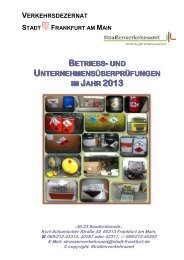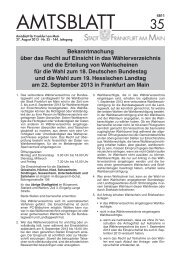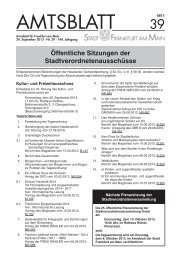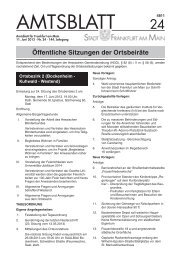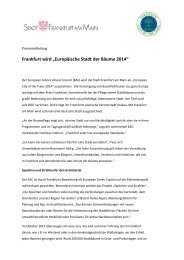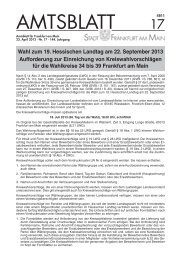Passiv houses in Frankfurt/Main – building the ... - Frankfurt am Main
Passiv houses in Frankfurt/Main – building the ... - Frankfurt am Main
Passiv houses in Frankfurt/Main – building the ... - Frankfurt am Main
Create successful ePaper yourself
Turn your PDF publications into a flip-book with our unique Google optimized e-Paper software.
Def<strong>in</strong>ition of <strong>Passiv</strong>e <strong>houses</strong><br />
<strong>Passiv</strong>e <strong>houses</strong>? What are <strong>the</strong>y?<br />
On <strong>the</strong> outside, passive <strong>houses</strong> do not look any different than<br />
conventional build<strong>in</strong>gs. ‘<strong>Passiv</strong>e house’ is not a brand n<strong>am</strong>e or<br />
build<strong>in</strong>g design. It is a quality standard comb<strong>in</strong><strong>in</strong>g high comfort<br />
with very low energy consumption.<br />
What is <strong>the</strong> passive aspect?<br />
<strong>Passiv</strong>e components, such as efficient heat <strong>in</strong>sulation, highly<br />
efficient ventilation systems with heat recovery, <strong>in</strong>sulated<br />
w<strong>in</strong>dow fr<strong>am</strong>es with triple glaz<strong>in</strong>g, airtight build<strong>in</strong>g envelopes, optimum<br />
daylight alignment and <strong>the</strong> avoidance of <strong>the</strong>rmal bridges,<br />
ensure that passive <strong>houses</strong> reta<strong>in</strong> heat which consequently does<br />
not need to be supplied. In addition, passive heat sources, such<br />
as solar radiation, waste heat produced by electric appliances and<br />
humans as well as heat from exhaust air, cover a large proportion<br />
of <strong>the</strong> heat requirement. With <strong>the</strong> heat energy produced by children<br />
contribut<strong>in</strong>g substantially to <strong>the</strong> heat<strong>in</strong>g of rooms, schools<br />
or day-care centres are ideally suited to a passive house design.<br />
What are <strong>the</strong> advantages compared to conventional build<strong>in</strong>gs?<br />
The overall concept results <strong>in</strong> a significant reduction <strong>in</strong> energy consumption compared to conventional build<strong>in</strong>gs.<br />
<strong>Frankfurt</strong> /Ma<strong>in</strong> frontrunner <strong>in</strong> passive house construction<br />
On 6 September 2007, <strong>the</strong> city parli<strong>am</strong>ent passed a resolution stipulat<strong>in</strong>g passive house standards for all new build<strong>in</strong>gs, <strong>the</strong>reby<br />
corroborat<strong>in</strong>g <strong>the</strong> pioneer<strong>in</strong>g role played by <strong>the</strong> city of <strong>Frankfurt</strong>/Ma<strong>in</strong> <strong>in</strong> <strong>the</strong> German energy transition.<br />
A fur<strong>the</strong>r ground-break<strong>in</strong>g step followed <strong>in</strong> 2010 when a landmark decision <strong>in</strong> favour of passive house specifications for all cityowned<br />
build<strong>in</strong>gs was passed. The parli<strong>am</strong>ent also stipulated that city properties may not be sold unless <strong>the</strong> respective build<strong>in</strong>g<br />
projects comply with passive house standards. <strong>Frankfurt</strong>’s public works department and ABG <strong>Frankfurt</strong> Hold<strong>in</strong>g assumed a<br />
ground-break<strong>in</strong>g role with<strong>in</strong> Germany. The variety of passive build<strong>in</strong>gs constructed by <strong>the</strong> public works department ranges from<br />
schools to day-care centres and passive house components <strong>in</strong> build<strong>in</strong>g refurbishment. As early as 2006, <strong>the</strong> municipal hous<strong>in</strong>g<br />
and real estate group ABG undertook to construct all new build<strong>in</strong>gs accord<strong>in</strong>g to passive house standards.<br />
Fur<strong>the</strong>rmore, <strong>the</strong> city set up passive house subsidy progr<strong>am</strong>mes to create f<strong>in</strong>ancial <strong>in</strong>centives for property developers. Hous<strong>in</strong>g<br />
development subsidies have been l<strong>in</strong>ked to <strong>the</strong> build<strong>in</strong>g design, for ex<strong>am</strong>ple <strong>in</strong> social hous<strong>in</strong>g and student residences. Under<br />
fur<strong>the</strong>r progr<strong>am</strong>mes, builders receive subsidies if <strong>the</strong>y opt for passive house standards <strong>in</strong> projects such as f<strong>am</strong>ily and senior<br />
citizen hous<strong>in</strong>g developments. Refurbishments <strong>in</strong> passive house quality also qualify for subsidies of <strong>the</strong> city.<br />
Noticeable results were already achieved <strong>in</strong> May 2009: ow<strong>in</strong>g to <strong>the</strong> city’s large number of passive house apartments, build<strong>in</strong>gs<br />
and projects, <strong>Frankfurt</strong> assumed <strong>the</strong> title of ‘<strong>Passiv</strong>e House Capital’ on <strong>the</strong> occasion of <strong>the</strong> 13th <strong>Passiv</strong>e House Conference. Aside<br />
from three schools and several day-care centres, over 1,500 apartments cover<strong>in</strong>g a surface area of 300,000 square metres are<br />
currently built to passive house standards. The long list of planned developments comprises 50 projects, <strong>am</strong>ong <strong>the</strong>m <strong>the</strong> first<br />
passive house hospital worldwide. The endeavours undertaken <strong>in</strong> this field have paid off: s<strong>in</strong>ce 1990, energy management has<br />
resulted <strong>in</strong> profits <strong>in</strong> excess of 100 million.<br />
Guidel<strong>in</strong>es on cost-effective construction<br />
Focuss<strong>in</strong>g on ‘cost-effective’ as opposed to ‘cheap’, <strong>the</strong> city of <strong>Frankfurt</strong> has drawn up guidel<strong>in</strong>es on cost-effective construction<br />
<strong>in</strong> order to cut <strong>the</strong> total cost of public construction. The guidel<strong>in</strong>es are based on <strong>the</strong> build<strong>in</strong>gs’ life cycle. The aim is to m<strong>in</strong>imise<br />
capital, operat<strong>in</strong>g and environmental follow-up costs, all <strong>the</strong> way from <strong>the</strong> plann<strong>in</strong>g stage to demolition and disposal. All public<br />
construction projects and all contracts concluded with architects and eng<strong>in</strong>eers have been subject to <strong>the</strong> guidel<strong>in</strong>es s<strong>in</strong>ce 2005.<br />
The guidel<strong>in</strong>es are available for download, also <strong>in</strong> English, at www.energiemanagement.stadt-frankfurt.de.<br />
Comparison <strong>–</strong> passive house / conventional house:<br />
On average, <strong>the</strong> mean specific heat consumption <strong>in</strong> schools and day-care centres <strong>in</strong> <strong>the</strong> city of <strong>Frankfurt</strong> /Ma<strong>in</strong> <strong>am</strong>ounts to<br />
142 kWh/m² per year. Normal use of passive <strong>houses</strong> results <strong>in</strong> a heat<strong>in</strong>g requirement of 15 kWh/m² (15 kWh are consistent with<br />
approx. 1.5 litres of oil or 1.5 m 3 of natural gas). This represents an almost 90% sav<strong>in</strong>g compared to <strong>the</strong> average consumption.<br />
<strong>Passiv</strong>e <strong>houses</strong> also offer substantially greater comfort: drafts, cold corners or draughty w<strong>in</strong>dow areas are a th<strong>in</strong>g of <strong>the</strong> past<br />
and <strong>the</strong> ventilation system ma<strong>in</strong>ta<strong>in</strong>s high air quality standards at all times.<br />
<strong>Passiv</strong>e <strong>houses</strong> are good-natured and forgive mistakes<br />
<strong>Passiv</strong>e <strong>houses</strong> do not require different behaviour than normal build<strong>in</strong>gs. With radiators not <strong>in</strong>stalled underneath <strong>the</strong> w<strong>in</strong>dows,<br />
if w<strong>in</strong>dows are accidentally left open, <strong>the</strong> <strong>houses</strong> do not necessarily lose heat. Due to <strong>the</strong> quality of <strong>the</strong> shell surface, temporary<br />
breakdowns of <strong>the</strong> heat<strong>in</strong>g system are hardly noticeable. Hence, a few details are different from conventional school build<strong>in</strong>gs.<br />
May <strong>the</strong> w<strong>in</strong>dows <strong>in</strong> a passive house be opened?<br />
Yes, <strong>the</strong>y may be opened but do not have to be. Dur<strong>in</strong>g <strong>the</strong> heat<strong>in</strong>g period, <strong>the</strong> ventilation system automatically ma<strong>in</strong>ta<strong>in</strong>s<br />
hygienic basic ventilation conditions without layers of cold air or drafts. If necessary, to guarantee good air quality, w<strong>in</strong>dows<br />
and doors should be opened for brief <strong>in</strong>tense air<strong>in</strong>g even dur<strong>in</strong>g <strong>the</strong> heat<strong>in</strong>g period. In autumn, spr<strong>in</strong>g and summer, when heat<br />
recovery is undesirable, <strong>the</strong> ventilation system should be switched off and <strong>the</strong> house should be aired through open w<strong>in</strong>dows.<br />
What is <strong>the</strong> difference between passive house w<strong>in</strong>dows and standard w<strong>in</strong>dows?<br />
W<strong>in</strong>dows <strong>in</strong> passive <strong>houses</strong> have triple glaz<strong>in</strong>g and are equipped with high-quality fr<strong>am</strong>e <strong>in</strong>sulation. With w<strong>in</strong>dows look<strong>in</strong>g<br />
south, <strong>the</strong>y admit more solar energy <strong>in</strong>to <strong>the</strong> build<strong>in</strong>g than heat is emitted to <strong>the</strong> outside. Thanks to <strong>the</strong> warmer surface temperatures<br />
ensured by triple glaz<strong>in</strong>g, radiators do not need to be <strong>in</strong>stalled directly under <strong>the</strong> w<strong>in</strong>dows.<br />
Do passive <strong>houses</strong> get too hot <strong>in</strong> summer?<br />
No, well-<strong>in</strong>sulated build<strong>in</strong>g envelopes protect <strong>the</strong> <strong>houses</strong> not only <strong>in</strong> w<strong>in</strong>ter but also <strong>in</strong> summer. Heat does not penetrate <strong>the</strong><br />
envelope. As a rule, rooms overheat due to solar irradiation through <strong>the</strong> w<strong>in</strong>dows. A comfortable room <strong>am</strong>bience also requires<br />
early use of solar protection. In longer heat periods, natural overnight ventilation is ensured via w<strong>in</strong>dows or night ventilation<br />
flaps. The ventilation system does not condition <strong>the</strong> air <strong>in</strong> summer s<strong>in</strong>ce it nei<strong>the</strong>r cools nor dehumidifies <strong>the</strong> air.<br />
2 3




